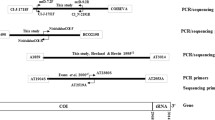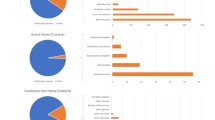Abstract
A DNA-based tool was validated that potentially enables the characterisation of both plant and insect of origin of small (approximately 1 ml) samples of bee honey. Using this method, mitochondrial, nuclear and chloroplast DNA (mtDNA, nuDNA, cpDNA) markers were successfully extracted, PCR amplified, and sequenced from a range of honeys, and the relative amount of plant nuDNA and cpDNA, and bee mtDNA in the samples was quantified using quantitative real-time PCR. Short, but taxonomically informative lengths of insect and plant organelle DNA could be routinely recovered from all honey samples tested, and longer organelle, and nuclear DNA sequences can be recovered from many. The data also enabled preliminary characterisation of the quality of these different DNA sources in honey. Although the absolute quantity of the different genetic markers varied considerably between sample, a general trend was observed of insect mtDNA dominating over plant organelle DNA, and with plant nuclear DNA at the lowest levels. Furthermore there was a clear correlation between the plant DNA content and the success of the PCR assays. To maximise successful characterisation of samples, future studies are recommended to focus on the use of organelle markers, and limit the size of PCR amplicons targeted, although with appropriate sample selection and assay optimisation, other approaches may be possible.

Similar content being viewed by others
References
Anklam E (1998) A review of the analytical methods to determine the geographical and botanical origin of honey. Food Chem 63:549–562
Cheng H, Jin W, Wu H, Wang F, You C, Peng Y, Jia S (2007) Isolation and PCR detection of foreign DNA sequences in bee honey raised on genetically modified Bt (Cry 1 Ac) cotton. Food Bioproducts Process 85:141–145
Crane E (1999) The world history of beekeeping and honey hunting. Routledge, New York
Deagle B, Eveson J, Jarman S (2006) Quantification of damage in DNA recovered from highly degraded samples—a case study on DNA in faeces. Front Zool 3:11
Greenleaf SS, Williams NM, Winfree R, Kremen C (2007) Bee foraging ranges and their relationship to body size. Oecologia 153:589–596
Herbert PDN, Ratnasingham S, deWaard JR (2004) Barcoding animal life: cytochrome c oxidase subunit I divergences among closely related species. Proc R Soc Lond B Biol Sci 270:313–321
Hill P, Wells P, Wells H (1997) Spontaneous flower constancy and learning in honey bees as a function of colour. Anim Behav 54:615–627
Kaufeld NM, Williams PH (1972) Honeybee as pollinators of pickling cucumbers in Wisconsin. Am Been J 112:252–254
Kress WJ, Wurdack KJ, Zimmer EA, Weigt LA, Janzen DH (2005) Use of DNA barcodes to identify flowering plants. Proc Nat Acad Sci U S A 102:8369–8374
Laube I, Hird H, Brodmann P, Ullmann S, Schöne-Michling M, Chisholm J, Broll H (2010) Development of primer and probe sets for the detection of plant species in honey. Food Chem 118:979–986
Lauro FM, Favaretto M, Covolo L, Rassu M, Bertoloni G (2002) Rapid detection of Paenibacillus larvae from honey and hive samples with a novel nested PCR protocol. Int J Food Microbiol 81:195–201
Meusnier I, Singer GAC, Landry J-F, Hickey DA, Herbert PDN, Hajibabaei M (2008) A universal DNA mini-barcode for biodiversity analysis. BMC Genomics 9:214
Munch K, Boomsma W, Huelsenbeck J, Willerslev E, Nielsen R (2008) Statistical Assignment of DNA Sequences Using Bayesian Phylogenetics. Syst Biol 57:750–757
Plant Working Group CBOL (2009) A DNA barcode for land Plants. Proc Nat Acad Sci U S A 106:1274–12797
Poinar HN, Hofreiter M, Spaulding WG, Martin P, Stankiewicz A, Bland H, Evershed R, Possnert G, Pääbo S (1998) Molecular coproscopy: dung and diet of the extinct ground sloth Nothrotheriops shastensis. Science 281:402–406
Poinar H, Schwarz C, Qi J, Shapiro B, Macphee R, Buiges B, Tikhonov A, Huson DH, Tomsho LP, Auch A, Rampp M, Miller W, Schuster SC (2006) Metagenomics to paleogenomics: large-scale sequencing of mammoth DNA. Science 311:392–394
Sang T (2002) Utility of low-copy nuclear gene sequences in plant phylogenetics. Crit Rev Biochem Mol Biol 37:121–147
Sodré G, Marchini L, Carvalho C, Moreti A (2007) Pollen analysis in honey samples from the two main producing regions in the Brazilian northeast. Anais da Academia Brasileira de Ciências 79:381–388
Taberlet P, Coissac E, Pompanon F, Gielly MiquelC, Valentine A, Vermat T, Corthier G, Brochmann C, Willerslev E (2007) Power and limitation of the chloroplast trnL (UAA) intron for plant DNA barcoding. Nucleic Acids Res 35:e14
Thomas RK, Nickerson E, Simons JF, Jänne PA, Tengs T et al (2006) Sensitive mutation detection in heterogenous cancer specimens by massively parallel picoliter reactor sequencing. Nat Med 12:852–855
Truchado P, Ferreres F, Bortolotti L, Sabatini AG (2008) Nectar flavonol rhamnosides are floral markers of acacia (Robinia pseudacacia) honey. J Agric Food Chem 56:8815–8824
Williams N, Kremen C (2007) Floral resource distribution among habitats determines productivity of a solitary bee, Osmia lignaria, in a mosaic agricultural landscape. Ecol Appl 17:910–921
Yang D, Eng B, Waye J, Dudar J, Saunders S (1998) Improved DNA extraction from ancient bones using silica-based spin columns. Am J Phys Anthropol 105:539–543
Acknowledgments
The authors would like to thank Simon Höjeberg for Gotland bee and honey samples. Funding for this research was provided by Biodlingscentrum Lövsta, Lövsta Landsbygdscentrum, Gotland (MF) and the Danish National Science Foundation (IBS, MTPG). The authors affirm that the experiments comply with the current laws of the country where the research was undertaken (Denmark).
Author information
Authors and Affiliations
Corresponding author
Additional information
Handling Editor: Neal Williams.
Rights and permissions
About this article
Cite this article
Schnell, I.B., Fraser, M., Willerslev, E. et al. Characterisation of insect and plant origins using DNA extracted from small volumes of bee honey. Arthropod-Plant Interactions 4, 107–116 (2010). https://doi.org/10.1007/s11829-010-9089-0
Received:
Accepted:
Published:
Issue Date:
DOI: https://doi.org/10.1007/s11829-010-9089-0




